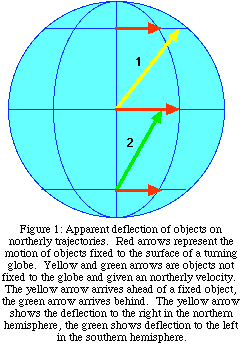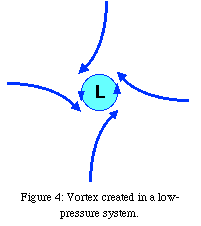Bart experimenting on the coriolis force..
One can find both counterclockwise and clockwise flowing drains
in both hemispheres. Some people would like you to believe that
the Coriolis force affects the flow of water down the drain in
sinks, bathtubs, or toilet bowls.
Don’t believe them! The
Coriolis force is simply too weak to affect such small bodies of
water.
Normally, objects in contact with the ground travel the
same speed as the ground they stand on. As a result, the Coriolis effect
generally doesn't have a noticeable effect to people on the ground; the
speed of the point you're standing on and the speed of the point you're
stepping onto are too close for you to tell the difference. Or, looking
back at the Coriolis effect equation above, if the velocity relative to
the rotating frame (the Earth) is zero, so is the Coriolis effect.
However, when an object moves north or south and is not
firmly connected to the ground (air, artillery fire, etc), then it
maintains its initial eastward speed as it moves. This is just an
application of Newton's First Law. An object moving east continues going
east at that speed (both direction and magnitude remain the same) until
something exerts a force on it to change its velocity. Objects launched
to the north from the equator retain the eastward component of velocity
of other objects sitting at the equator. But if they travel far enough
away from the equator, they will no longer be going east at the same
speed as the ground beneath them.
 The result is that an object traveling away from the
equator will eventually be heading east faster than the ground below it
and will seem to be moved east by some mysterious "force". Objects
traveling towards the equator will eventually be going more slowly than
the ground beneath them and will seem to be forced west. In reality
there is no actual force involved; the ground is simply moving at a
different speed than its original "home ground" speed, which the object
retains.
The result is that an object traveling away from the
equator will eventually be heading east faster than the ground below it
and will seem to be moved east by some mysterious "force". Objects
traveling towards the equator will eventually be going more slowly than
the ground beneath them and will seem to be forced west. In reality
there is no actual force involved; the ground is simply moving at a
different speed than its original "home ground" speed, which the object
retains.
Consider Figure 1. Yellow arrow 1 represents an object
sent north from the equator. By the time it reaches the labeled northern
latitude, it has traveled farther east than a similar point on the ground
at that latitude has, since it kept the eastward speed it had when it
left the equator. Similarly, green arrow 2 started south of the equator
at a slower eastward speed, and doesn't go as far east as the ground at
the equator...seeming to deflect west from the point of view of the
ground.
Things moving towards the poles
curve to the east, things moving away from the poles curve to the west,
things moving east curve towards the equator and things moving west curve
towards the poles. In other words, air (or anything else) moving freely
in the northern hemisphere deflect to the right, air moving freely in the
southern hemisphere deflect to the left. And this is what the result of
the vector cross products in the Coriolis effect equation says as well, in
its mathematical shorthand.
What does this mean for, say, weather systems? Take,
for example, a low pressure center, where there's less air than in the
area around it. If there's less air in one place than in the
surroundings, air will try to move in to balance things out.
 Air starting at rest with respect to the ground will
move towards a low pressure center. Such motion in the Northern
Hemisphere will deflect to its right, as shown in Figure 4. However, the
forces which got the air moving towards the low pressure center in the
first place are still around, and the result will be a vortex of air
spinning counter-clockwise. Air will try to turn to the right, the low
pressure system will try to draw the air into itself, and the result is
that air is held into a circle that actually turns to the left. Without
the Coriolis effect, fluid rushing in towards a point could still form a
vortex, but the direction would either be random or depend solely on the
initial conditions of the fluid.
The eye of a hurricane is a clear example of fast winds
bent into a tight circle, moving so fast that they can't be "pulled in" to
the center. The very low pressure at the center of the hurricane means that
there is a strong force pulling air towards the center, but the high speed of
the wind invokes the Coriolis effect strongly enough that the forces reach a
kind of balance. The net force on air at the eye wall is a centripetal force
large enough to keep the air out at a given radius determined by its
speed.
Air starting at rest with respect to the ground will
move towards a low pressure center. Such motion in the Northern
Hemisphere will deflect to its right, as shown in Figure 4. However, the
forces which got the air moving towards the low pressure center in the
first place are still around, and the result will be a vortex of air
spinning counter-clockwise. Air will try to turn to the right, the low
pressure system will try to draw the air into itself, and the result is
that air is held into a circle that actually turns to the left. Without
the Coriolis effect, fluid rushing in towards a point could still form a
vortex, but the direction would either be random or depend solely on the
initial conditions of the fluid.
The eye of a hurricane is a clear example of fast winds
bent into a tight circle, moving so fast that they can't be "pulled in" to
the center. The very low pressure at the center of the hurricane means that
there is a strong force pulling air towards the center, but the high speed of
the wind invokes the Coriolis effect strongly enough that the forces reach a
kind of balance. The net force on air at the eye wall is a centripetal force
large enough to keep the air out at a given radius determined by its
speed.

This low pressure system over Iceland spins counter-clockwise due to balance between the Coriolis force and the pressure gradient force.

